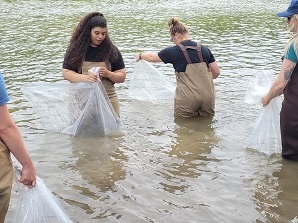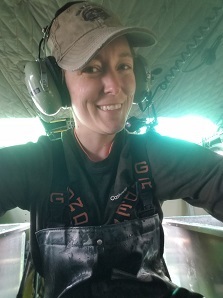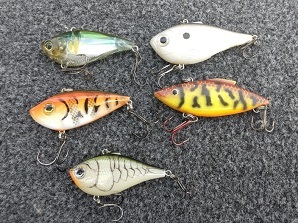Freshwater Fishing, Fisheries Management, and Fishing Access News In This Issue: - Free Fishing This Weekend
- Restoring American Shad in New York
- Fisheries Staff Spotlight - Rinnan Weekes
- Tackle Tips - Lipless Crankbaits
Free Fishing This Weekend  Summer's officially here and what better way to kick it off than dropping a line at your local fishing hole? This Saturday and Sunday (June 25 & 26) is Free Fishing Weekend here in New York. This means anyone can fish the fresh waters of the state without a fishing license, so it's a great opportunity to give it a try for the first time, introduce someone new to the sport, or reconnect with this fulfilling pastime. Summer's officially here and what better way to kick it off than dropping a line at your local fishing hole? This Saturday and Sunday (June 25 & 26) is Free Fishing Weekend here in New York. This means anyone can fish the fresh waters of the state without a fishing license, so it's a great opportunity to give it a try for the first time, introduce someone new to the sport, or reconnect with this fulfilling pastime.
Busy this weekend? Free fishing clinics held throughout the year not only waive the fishing license requirement, but also offer beginning fishing instruction. For a listing of currently scheduled programs, visit our website (The list is updated routinely, so check back often.) Check out the following resources to help you plan your next trip on the water: Places to Fish in New York
I FISH NY Beginners Guide to Freshwater Fishing
Getting Started in Fishing Video Series
Restoring American Shad in New York  As part of an effort to restore American shad in New York, DEC Fisheries staff, in collaboration with the PA Fish and Boat Commission, recently stocked 322,000 American shad fry into the Susquehanna River in Endicott, NY. The eggs and milt were collected from Potomac River fish and reared at the Van Dyke State Fish Hatchery in Pennsylvania for 30 days before making their journey up to New York. Prior to stocking, fish were marked so in the event they're recaptured, staff will be able to obtain useful information on fish growth, movement and stocking success. Stocking the shad further upstream will give them more time to grow larger, hopefully increasing their chance of survival and ultimately the success of restoring this migratory species. As part of an effort to restore American shad in New York, DEC Fisheries staff, in collaboration with the PA Fish and Boat Commission, recently stocked 322,000 American shad fry into the Susquehanna River in Endicott, NY. The eggs and milt were collected from Potomac River fish and reared at the Van Dyke State Fish Hatchery in Pennsylvania for 30 days before making their journey up to New York. Prior to stocking, fish were marked so in the event they're recaptured, staff will be able to obtain useful information on fish growth, movement and stocking success. Stocking the shad further upstream will give them more time to grow larger, hopefully increasing their chance of survival and ultimately the success of restoring this migratory species.
Fisheries Staff Spotlight - Rinnan Weekes  I'm a Fish Culturist 2 at the Chateaugay Fish Hatchery. After graduating in 2009 from SUNY-ESF with a degree in Aquatic and Fisheries Science I spent several years at various seasonal jobs, primarily in outdoor education. I worked for NYS Office of Parks, Recreation and Historic Preservation, a non-profit nature preserve in the Hudson Valley, and a few other odd jobs to fill out my schedule before starting here at DEC in 2019. I'm a Fish Culturist 2 at the Chateaugay Fish Hatchery. After graduating in 2009 from SUNY-ESF with a degree in Aquatic and Fisheries Science I spent several years at various seasonal jobs, primarily in outdoor education. I worked for NYS Office of Parks, Recreation and Historic Preservation, a non-profit nature preserve in the Hudson Valley, and a few other odd jobs to fill out my schedule before starting here at DEC in 2019.
Some of the things that I loved about outdoor education have carried over to my career in fish culture – like working primarily outside, giving tours to the public, and getting to see lots of cool spots that I otherwise wouldn't have known about. As the Fish Culturist 2, I help supervise and assist in hatchery management, but I'm also out on the road stocking rainbow, brown, brook, and lake trout primarily in DEC Regions 5 & 6, and sometimes transporting fish for other state and federal hatcheries as well. I'd say my favorite part of hatchery work is the cyclical nature of raising fish. The work changes as the seasons change. There's a sense of satisfaction in watching a year and a half of work get loaded up to leave the hatchery during spring stocking season. Outside of work I like to spend time with my husband and daughter, who will be turning one in July. We plan to spend a lot of the summer introducing her to more of the outdoors with lots of walks, hikes, and swims. When I get free time I like to keep it simple - sitting by a campfire, taking the kayak out, or working on art projects.
Tackle Tips - Lipless Crankbaits  Lipless crankbaits have been around for quite a while but are often overlooked with all the new lure styles on the market nowadays. Basically, lipless crankbaits, as the name implies, are crankbaits with no lips. Most have rattles that produce a lot of sound and vibration. Lipless crankbaits have been around for quite a while but are often overlooked with all the new lure styles on the market nowadays. Basically, lipless crankbaits, as the name implies, are crankbaits with no lips. Most have rattles that produce a lot of sound and vibration.
Profile: they vary in size from 2" to 4" but the "standard" size is around 3". They come in an amazing number of colors, but having a shad, chrome or crayfish pattern is a good starting point. Technique: They can be fished in several ways but the two most common are the straight retrieve and "yo-yoing." The straight retrieve is done by casting the bait out and reeling it in at a steady speed. "Yo-yoing" is done by casting it out letting it fall and then raising it up and letting it fall again. Tips: - Occasionally contacting vegetation and then ripping (a hard yank on the line like a hook set) can often produce more hits.
- A glass/graphite composite rod that has some "give" works best with most crankbaits.
- Changing line size can help with depth the bait runs. Heavier line will keep it more near the surface, while a lighter line will help get deeper.
|  Summer's officially here and what better way to kick it off than dropping a line at your local fishing hole? This Saturday and Sunday (June 25 & 26) is
Summer's officially here and what better way to kick it off than dropping a line at your local fishing hole? This Saturday and Sunday (June 25 & 26) is  As part of an effort to restore American shad in New York, DEC Fisheries staff, in collaboration with the PA Fish and Boat Commission, recently stocked 322,000 American shad fry into the Susquehanna River in Endicott, NY. The eggs and milt were collected from Potomac River fish and reared at the Van Dyke State Fish Hatchery in Pennsylvania for 30 days before making their journey up to New York. Prior to stocking, fish were marked so in the event they're recaptured, staff will be able to obtain useful information on fish growth, movement and stocking success. Stocking the shad further upstream will give them more time to grow larger, hopefully increasing their chance of survival and ultimately the success of restoring this migratory species.
As part of an effort to restore American shad in New York, DEC Fisheries staff, in collaboration with the PA Fish and Boat Commission, recently stocked 322,000 American shad fry into the Susquehanna River in Endicott, NY. The eggs and milt were collected from Potomac River fish and reared at the Van Dyke State Fish Hatchery in Pennsylvania for 30 days before making their journey up to New York. Prior to stocking, fish were marked so in the event they're recaptured, staff will be able to obtain useful information on fish growth, movement and stocking success. Stocking the shad further upstream will give them more time to grow larger, hopefully increasing their chance of survival and ultimately the success of restoring this migratory species. I'm a Fish Culturist 2 at the Chateaugay Fish Hatchery. After graduating in 2009 from SUNY-ESF with a degree in Aquatic and Fisheries Science I spent several years at various seasonal jobs, primarily in outdoor education. I worked for NYS Office of Parks, Recreation and Historic Preservation, a non-profit nature preserve in the Hudson Valley, and a few other odd jobs to fill out my schedule before starting here at DEC in 2019.
I'm a Fish Culturist 2 at the Chateaugay Fish Hatchery. After graduating in 2009 from SUNY-ESF with a degree in Aquatic and Fisheries Science I spent several years at various seasonal jobs, primarily in outdoor education. I worked for NYS Office of Parks, Recreation and Historic Preservation, a non-profit nature preserve in the Hudson Valley, and a few other odd jobs to fill out my schedule before starting here at DEC in 2019. Lipless crankbaits have been around for quite a while but are often overlooked with all the new lure styles on the market nowadays. Basically, lipless crankbaits, as the name implies, are crankbaits with no lips. Most have rattles that produce a lot of sound and vibration.
Lipless crankbaits have been around for quite a while but are often overlooked with all the new lure styles on the market nowadays. Basically, lipless crankbaits, as the name implies, are crankbaits with no lips. Most have rattles that produce a lot of sound and vibration.
No comments:
Post a Comment